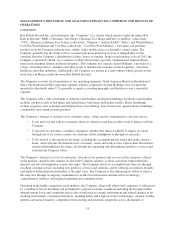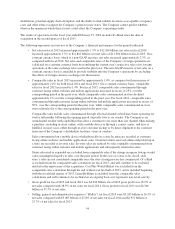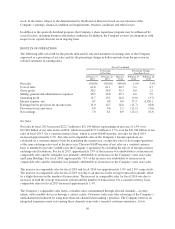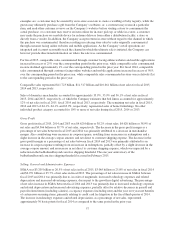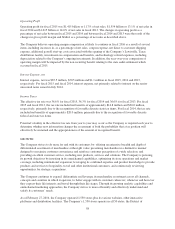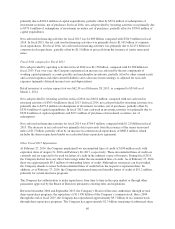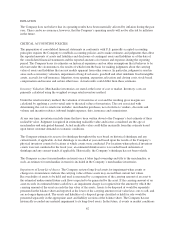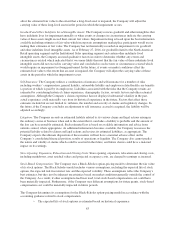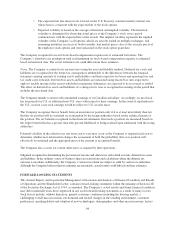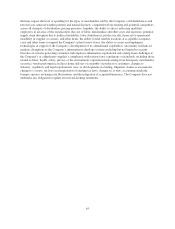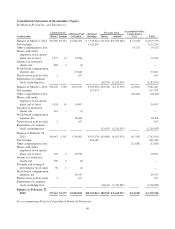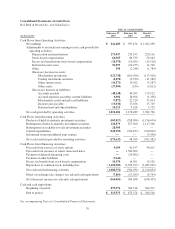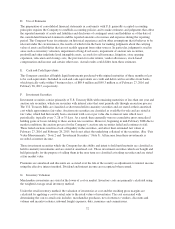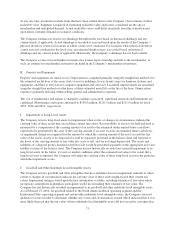Bed, Bath and Beyond 2015 Annual Report Download - page 75
Download and view the complete annual report
Please find page 75 of the 2015 Bed, Bath and Beyond annual report below. You can navigate through the pages in the report by either clicking on the pages listed below, or by using the keyword search tool below to find specific information within the annual report.affect the estimated fair value to the extent that a long-lived asset is impaired, the Company will adjust the
carrying value of these long-lived assets in the period in which the impairment occurs.
Goodwill and Other Indefinite Lived Intangible Assets: The Company reviews goodwill and other intangibles that
have indefinite lives for impairment annually or when events or changes in circumstances indicate the carrying
value of these assets might exceed their current fair values. Impairment testing is based upon the best information
available including estimates of fair value which incorporate assumptions marketplace participants would use in
making their estimates of fair value. The Company has not historically recorded an impairment to its goodwill
and other indefinite lived intangible assets. As of February 27, 2016, for goodwill related to the North American
Retail operating segment and the Institutional Sales operating segment and certain other indefinite lived
intangible assets, the Company assessed qualitative factors in order to determine whether any events and
circumstances existed which indicated that it was more likely than not that the fair value of these indefinite lived
intangible assets did not exceed its carrying value and concluded no such events or circumstances existed which
would require an impairment test being performed. In the future, if events or market conditions affect the
estimated fair value to the extent that an asset is impaired, the Company will adjust the carrying value of these
assets in the period in which the impairment occurs.
Self Insurance: The Company utilizes a combination of insurance and self insurance for a number of risks
including workers’ compensation, general liability, automobile liability and employee related health care benefits
(a portion of which is paid by its employees). Liabilities associated with the risks that the Company retains are
estimated by considering historical claims experience, demographic factors, severity factors and other actuarial
assumptions. Although the Company’s claims experience has not displayed substantial volatility in the past,
actual experience could materially vary from its historical experience in the future. Factors that affect these
estimates include but are not limited to: inflation, the number and severity of claims and regulatory changes. In
the future, if the Company concludes an adjustment to self insurance accruals is required, the liability will be
adjusted accordingly.
Litigation: The Company records an estimated liability related to its various claims and legal actions arising in
the ordinary course of business when and to the extent that it concludes a liability is probable and the amount of
the loss can be reasonably estimated. Such estimated loss is based on available information and advice from
outside counsel, where appropriate. As additional information becomes available, the Company reassesses the
potential liability related to claims and legal actions and revises its estimated liabilities, as appropriate. The
Company expects the ultimate disposition of these matters will not have a material adverse effect on the
Company’s consolidated financial position, results of operations or liquidity. The Company also cannot predict
the nature and validity of claims which could be asserted in the future, and future claims could have a material
impact on its earnings.
Store Opening, Expansion, Relocation and Closing Costs: Store opening, expansion, relocation and closing costs,
including markdowns, asset residual values and projected occupancy costs, are charged to earnings as incurred.
Stock-Based Compensation: The Company uses a Black-Scholes option-pricing model to determine the fair value
of its stock options. The Black-Scholes model includes various assumptions, including the expected life of stock
options, the expected risk free interest rate and the expected volatility. These assumptions reflect the Company’s
best estimates, but they involve inherent uncertainties based on market conditions generally outside the control of
the Company. As a result, if other assumptions had been used, total stock-based compensation cost could have
been materially impacted. Furthermore, if the Company uses different assumptions for future grants, stock-based
compensation cost could be materially impacted in future periods.
The Company determines its assumptions for the Black-Scholes option-pricing model in accordance with the
accounting guidance related to stock compensation.
• The expected life of stock options is estimated based on historical experience.
63


